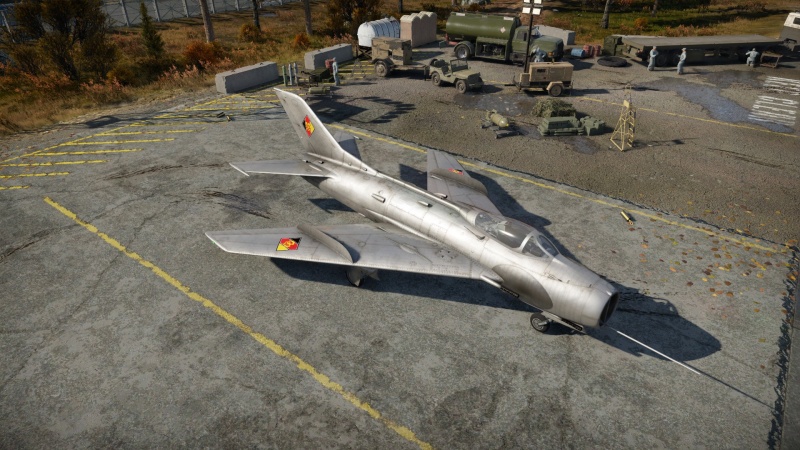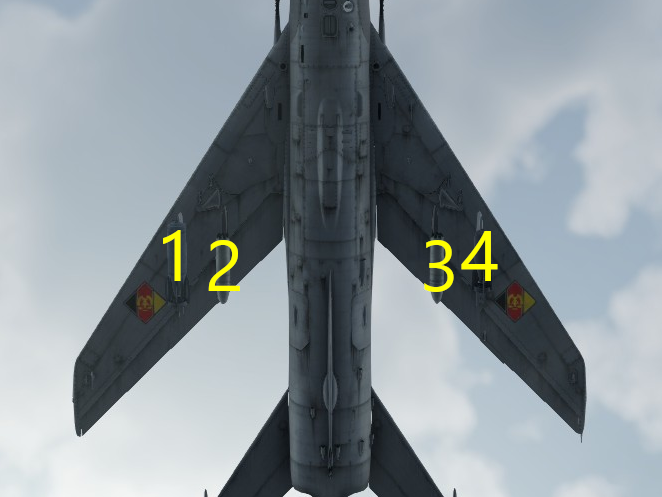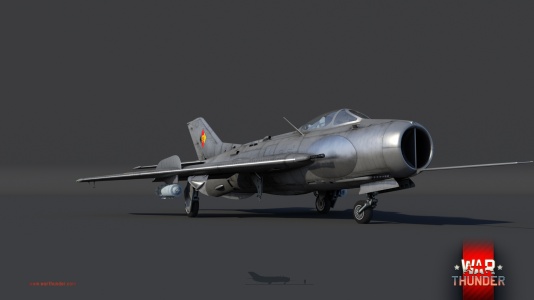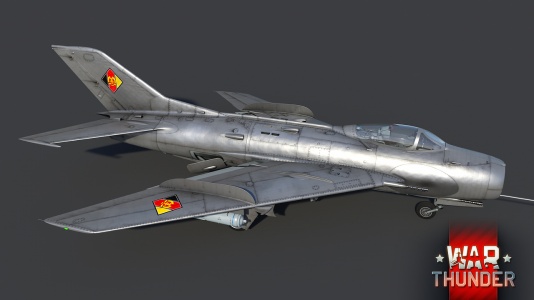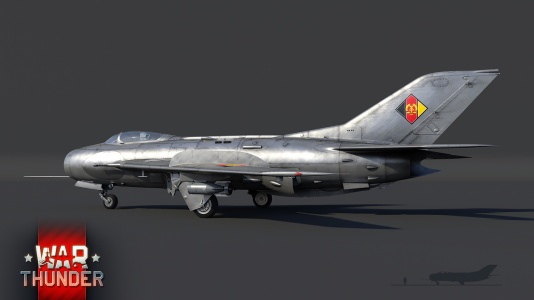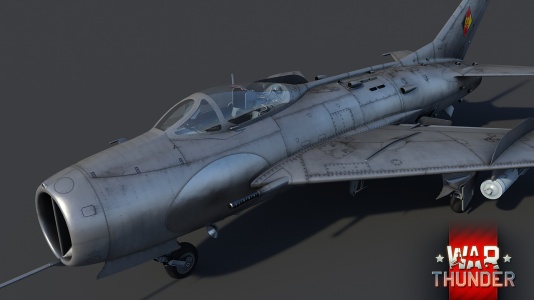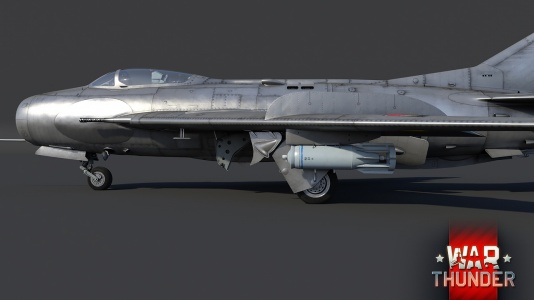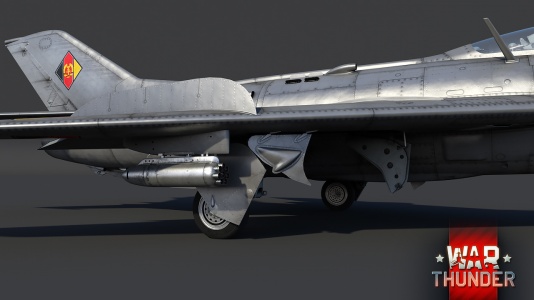Difference between revisions of "MiG-19S (Germany)"
(→Pros and cons) (Tag: Visual edit) |
m (→Usage in battles) |
||
| (5 intermediate revisions by 2 users not shown) | |||
| Line 174: | Line 174: | ||
== Usage in battles == | == Usage in battles == | ||
<!-- ''Describe the tactics of playing in the aircraft, the features of using aircraft in a team and advice on tactics. Refrain from creating a "guide" - do not impose a single point of view, but instead, give the reader food for thought. Examine the most dangerous enemies and give recommendations on fighting them. If necessary, note the specifics of the game in different modes (AB, RB, SB).'' --> | <!-- ''Describe the tactics of playing in the aircraft, the features of using aircraft in a team and advice on tactics. Refrain from creating a "guide" - do not impose a single point of view, but instead, give the reader food for thought. Examine the most dangerous enemies and give recommendations on fighting them. If necessary, note the specifics of the game in different modes (AB, RB, SB).'' --> | ||
| − | Farmer pilots will need to rely on the power of their engines above all else to come out victorious in battle. Little at | + | Farmer pilots will need to rely on the power of their engines above all else to come out victorious in battle. Little at similar tier can match the raw power of the MiG-19S's dual afterburning engines, which allow the pilot the safety to deal with slower aircraft at his or her own pace, as the defender slowly loses their energy. |
Though the MiG-19S's top speed is lower than some of its contemporaries, such as the [[F-4C Phantom II]] or [[J-7II]], the Farmer instead boasts an immense thrust-to-weight ratio when the afterburner is active, allowing pilots to engage in energy-burning manoeuvres with faster opponents, who will struggle to keep up with the acceleration of the MiG-19 when recovering speed afterwards. A smart Farmer pilot will abuse this to turn seemingly untouchable faster opponents into easy prey. A reliable tactic when an enemy is on your tail is entering an upward spiral. The MiG's monstrous Thrust-to-Weight Ratio and turn rate will leave most opponents in the dust, forcing the enemy to either disengage or bleed away energy in a futile attempt to keep up. Pilots must keep in mind that some opponents like the [[Mirage IIIC]], [[J35D]], and to a lesser extent [[MiG-21F-13|MiG-21]] can simply turn inside the MiG-19S and shoot you full of holes, so this strategy should be applied with discretion. | Though the MiG-19S's top speed is lower than some of its contemporaries, such as the [[F-4C Phantom II]] or [[J-7II]], the Farmer instead boasts an immense thrust-to-weight ratio when the afterburner is active, allowing pilots to engage in energy-burning manoeuvres with faster opponents, who will struggle to keep up with the acceleration of the MiG-19 when recovering speed afterwards. A smart Farmer pilot will abuse this to turn seemingly untouchable faster opponents into easy prey. A reliable tactic when an enemy is on your tail is entering an upward spiral. The MiG's monstrous Thrust-to-Weight Ratio and turn rate will leave most opponents in the dust, forcing the enemy to either disengage or bleed away energy in a futile attempt to keep up. Pilots must keep in mind that some opponents like the [[Mirage IIIC]], [[J35D]], and to a lesser extent [[MiG-21F-13|MiG-21]] can simply turn inside the MiG-19S and shoot you full of holes, so this strategy should be applied with discretion. | ||
| Line 209: | Line 209: | ||
* Notably short takeoff run for a high-tier jet | * Notably short takeoff run for a high-tier jet | ||
* Access to a drogue chute for high-speed landings (deploys automatically below 300 km/h) | * Access to a drogue chute for high-speed landings (deploys automatically below 300 km/h) | ||
| − | |||
| − | |||
* Can perform combat manoeuvres which even modern fly-by-wire aircraft struggle with | * Can perform combat manoeuvres which even modern fly-by-wire aircraft struggle with | ||
| Line 259: | Line 257: | ||
;Related development | ;Related development | ||
| − | |||
* Mikoyan-Gurevich [[MiG-19PT]] | * Mikoyan-Gurevich [[MiG-19PT]] | ||
* Mikoyan-Gurevich [[MiG-17]] | * Mikoyan-Gurevich [[MiG-17]] | ||
Latest revision as of 09:16, 26 April 2024
| This page is about the German jet fighter MiG-19S (Germany). For other versions, see MiG-19 (Family). |
Contents
Description
The MiG-19S was a special variant of the MiG-19, incorporating an all-moving slab tail and the Svod long-range navigation receiver. It was armed with three 30 mm NR-30 cannons in comparison to the two found on most other models. The MiG-19S entered production in 1956, and was exported to multiple countries shortly after. One of the countries to receive and use the MiG-19S was Germany, which operated 12 MiG-19S alongside 12 other aircraft of the MiG-19PM variant. The German MiG-19s would serve until 1969, when they were replaced with mid-life models of the MiG-21, such as the MiG-21SPS-K and MiG-21MF
The ◊MiG-19S (NATO designation: "Farmer-C") was introduced in Update 1.87 "Locked On" as the German equivalent to the MiG-19PT found in the Soviet tech tree. The MiG-19S may seem worse at first, but in the hands of an experienced pilot, it is merely a sidegrade, if not better than its Soviet tree counterpart. Unlike the PT in the Soviet tree, the German MiG-19S lacks any air-to-air missiles or dedicated search and track radar systems. However, due to the absence of such systems, the aircraft is noticeably lighter. The MiG-19S also receives an extra gun, giving it more firepower and ammo to use. All in all, the MiG-19S is a great introduction to supersonic jets, as it has great performance and flight characteristics, allowing players of the German tech tree to learn kinematic missile evasion techniques and higher tier dogfight doctrine, aspects that the F-104G on the other side of the tech tree lacks.
General info
Flight performance
The MiG-19S 'Farmer' serves as a capable supersonic fighter boasting an incredible thrust-to-weight ratio, a highly competitive top speed, and lethal primary armaments. Thanks to the two afterburning turbojet engines, the MiG-19S is able to accelerate very well at all speeds and can use this thrust to achieve a considerable climb rate matched by nearly no other aircraft at its tier. In exchange for these great engines however, MiG-19S pilots will find their fighter's manoeuvrability moderately worse than their opponents, with the Farmer's rudder being especially poor compared to its contemporaries. Elevator authority is not terrible, but subsonic fighter jets will easily beat out a MiG-19S in a turning engagement.
Thanks to the plane's access to a drogue chute, as well as the relatively strong landing gear, the MiG-19S is capable of pulling of high-speed landings, with a touchdown at over 350 km/h being easily possible. The plane's high thrust-to-weight also allows it to take off quicker than most other jets it will find itself with and against.
| Characteristics | Max Speed (km/h at 10,000 m) |
Max altitude (metres) |
Turn time (seconds) |
Rate of climb (metres/second) |
Take-off run (metres) | |||
|---|---|---|---|---|---|---|---|---|
| AB | RB | AB | RB | AB | RB | |||
| Stock | 1,441 | 1,436 | 17700 | 24.4 | 24.7 | 164.7 | 156.8 | 515 |
| Upgraded | 1,465 | 1,451 | 23.6 | 24.0 | 217.2 | 190.0 | ||
Details
| Features | |||||
|---|---|---|---|---|---|
| Combat flaps | Take-off flaps | Landing flaps | Air brakes | Arrestor gear | Drogue chute |
| X | ✓ | ✓ | ✓ | X | ✓ |
| Limits | ||||||
|---|---|---|---|---|---|---|
| Wings (km/h) | Gear (km/h) | Flaps (km/h) | Max Static G | |||
| Combat | Take-off | Landing | + | - | ||
| 1260 | 577 | N/A | 500 | 450 | ~12 | ~5 |
| Optimal velocities (km/h) | |||
|---|---|---|---|
| Ailerons | Rudder | Elevators | Radiator |
| < 540 | < 650 | < 350 | N/A |
Engine performance
| Engine | Aircraft mass | |||||
|---|---|---|---|---|---|---|
| Engine name | Number | Basic mass | Wing loading (full fuel) | |||
| Mikulin RD-9B | 2 | 5,550 kg | 292 kg/m2 | |||
| Engine characteristics | Mass with fuel (no weapons load) | Max Takeoff Weight | ||||
| Weight (each) | Type | 7m fuel | 20m fuel | 25m fuel | ||
| 725 kg | Afterburning axial-flow turbojet | 6,090 kg | 6,951 kg | 7,350 kg | 8,832 kg | |
| Maximum engine thrust @ 0 m (RB/SB) | Thrust to weight ratio @ 0 m (WEP) | |||||
| Condition | 100% | WEP | 7m fuel | 20m fuel | 25m fuel | MTOW |
| Stationary | 2,296 kgf | 3,218 kgf | 1.06 | 0.93 | 0.88 | 0.73 |
| Optimal | 2,320 kgf (1,000 km/h) |
3,284 kgf (1,000 km/h) |
1.08 | 0.94 | 0.89 | 0.74 |
Survivability and armour
- 64 mm Bulletproof glass in front of the pilot
- 10 mm Steel plate in front of the cockpit
- 16.5 mm Steel plate in the pilot's seat
As is typical of more modern aircraft, the MiG-19S does not take damage well. Though the pilot is well-protected against HE rounds from the front, almost the entirety of the plane's middle and rear fuselage is taken up by the MiG-19S's two engines which are thus incredibly easy to hit. Thanks to the plane's heavy reliance on the power of those engines, any damage to either or both of them causes massive problems to the Farmer. Loss of thrust harms the plane immensely, as the MiG-19's lack of manoeuvrability leaves it with little options against a persistent foe while it has damaged engines. The MiG-19 can also suffer from asymmetric thrust (when one engine is more damaged than another) causing the plane to struggle heavily at low speeds, due to the weak rudder potentially struggling to compensate.
Modifications and economy
Armaments
Offensive armament
The MiG-19S (Germany) is armed with:
- 1 x 30 mm NR-30 cannons, chin-mounted (70 rpg)
- 2 x 30 mm NR-30 cannons, wing-mounted (70 rpg = 140 total)
The MiG-19S's 30 mm NR-30 cannons are highly devastating, rarely dealing anything less than a fatal blow thanks to their high calibre. They also boast a great muzzle velocity, most comparable to the British 30 mm ADEN cannon, aiding the pilot against high speed targets such as other supersonic jets. Their positions, all close to the nose of the aircraft, further improve the performance of these cannons.
However, the MiG-19S carries a paltry 70 rounds per gun which combines with the high fire rate of 1,000 RPM to punish poor aim and careless trigger discipline heavily, as well as reducing the MiG-19S's ability to engage in prolonged battles, forming one of the MiG-19S's core weaknesses.
Suspended armament
The MiG-19S (Germany) can be outfitted with the following ordnance:
| 1 | 2 | 3 | 4 | ||
|---|---|---|---|---|---|
| 100 kg OFAB-100 bombs | 1 | 1 | |||
| 250 kg OFAB-250sv bombs | 1 | 1 | |||
| S-5K rockets | 8 | 8 | 8 | 8 |
| Default weapon presets | |
|---|---|
| |
Usage in battles
Farmer pilots will need to rely on the power of their engines above all else to come out victorious in battle. Little at similar tier can match the raw power of the MiG-19S's dual afterburning engines, which allow the pilot the safety to deal with slower aircraft at his or her own pace, as the defender slowly loses their energy.
Though the MiG-19S's top speed is lower than some of its contemporaries, such as the F-4C Phantom II or J-7II, the Farmer instead boasts an immense thrust-to-weight ratio when the afterburner is active, allowing pilots to engage in energy-burning manoeuvres with faster opponents, who will struggle to keep up with the acceleration of the MiG-19 when recovering speed afterwards. A smart Farmer pilot will abuse this to turn seemingly untouchable faster opponents into easy prey. A reliable tactic when an enemy is on your tail is entering an upward spiral. The MiG's monstrous Thrust-to-Weight Ratio and turn rate will leave most opponents in the dust, forcing the enemy to either disengage or bleed away energy in a futile attempt to keep up. Pilots must keep in mind that some opponents like the Mirage IIIC, J35D, and to a lesser extent MiG-21 can simply turn inside the MiG-19S and shoot you full of holes, so this strategy should be applied with discretion.
Due to the MiG-19S's very low ammunition count, it is important for pilots to consider their shots carefully. The MiG-19S has an amazing climb rate and energy retention, even with high fuel loads, so it may often be better to save ammo, hitting the afterburner to climb away and attempt another attack run later. The Farmer excels in the late game when enemies have run out of missile armament and energy, so players should be mindful to keep an ammo reserve to capitalize on this period.
Though the MiG-19S's selection of secondary armaments is limited, it can nonetheless use those armaments alongside the high top speed to perform hit and run attacks on valuable targets, such as Anti-Air in Combined Battles.
Radars
The MiG-19S is equipped with a SRD-1 rangefinding radar, located in the nose of the aircraft. It will automatically detect other planes within the scanning area and display the range to the closest target. It is linked with a gyro gunsight and can help with aiming at close range.
| SRD-1 - Rangefinding radar | |||
|---|---|---|---|
| Maximum Tracking Range |
Minimum Tracking Range |
Azimuth Tracking Angle |
Elevation Tracking Angle |
| 2,000 m | 150 m | ±9° | ±9° |
Pros and cons
Pros:
- Three powerful, high velocity 30 mm cannons
- Unparalleled thrust-to-weight ratio, providing excellent acceleration and climb rate
- Amongst the fastest of all aircraft at its BR
- Notably short takeoff run for a high-tier jet
- Access to a drogue chute for high-speed landings (deploys automatically below 300 km/h)
- Can perform combat manoeuvres which even modern fly-by-wire aircraft struggle with
Cons:
- No access to air-to-air missiles
- Poor ammunition count for primary armament
- No combat flaps setting, only takeoff and landing settings
- Compresses at high speed (1,000-1,200 km/h) without "New boosters" modification
- Incredibly underwhelming rudder performance at all speeds
- Highly susceptible to critical engine damage
- Unlike the PT variant, there is no radar available
History
The MiG-19 'Farmer' was the Soviet Union's first supersonic fighter jet to enter production, a successor to the MiG-17 which was developed itself from the MiG-15. The first MiG-19 entered service with the VSS in the mid-'50s. The MiG-19S is a later production variant of the Farmer, a day fighter with two RD-9B afterburning turbojets, outputting a hair over 7100lbs of thrust each when wet.
Compared to earlier variants of the MiG-19, the 'S' variant was equipped with provisions for rocket packs as well as bombs, giving it limited multi-role capability, though it did not have the radar of the MiG-19P, nor access to air-to-air missiles as with the MiG-19PT. For flight characteristics, the MiG-19S came out around 170kg lighter than the earlier MiG-19 variants and had a slightly redesigned airframe for improved aerodynamics.
On 10 March 1964, a USAF photo-reconnaissance aircraft RB-66 Destroyer was on a mission to observe a military exercise at the Gardelegen training range when it crossed over East German airspace. A pair of Russian MiG-19S Farmer-C fighters from the 24th Air Army base in East Germany were scrambled to intercept the photo-reconnaissance aircraft. Attempts to redirect the RB-66 failed even with warning shots fired from the MiG-19S fighters. Finally, Captain Vitaliy Ivannikov was given the order to shoot down the American aircraft which he successfully did. The three American crew members were captured and held for interrogation for four weeks before they were released.[1]
The MiG-19 did not see much combat under the Soviet flag. However, the MiG-19S, or rather a Chinese license-built MiG-19S called the Shenyang J-6, saw combat over Vietnam during the Vietnam War, flying in 1969 with the North Vietnamese Vietnam People's Air Force against USAF F-4 Phantom IIs. The Farmer scored a total of 7 victories against Phantoms over Vietnam.[2]
Media
- Skins
- Images
- Videos
See also
- Related development
- Aircraft of comparable role, configuration and era
- Dassault Super Mystère
- North American F-100 Super Sabre
- Mitsubishi T-2
External links
- [Development] MiG-19S: Magnificent Performance
- Official data sheet - more details about the performance
References
| Mikoyan-Gurevich Design Bureau (Микоя́н и Гуре́вич Опытное конструкторское бюро) | |
|---|---|
| Fighters | MiG-3-15 · MiG-3-15 (BK) · MiG-3-34 |
| I-225 | |
| Jet fighters | MiG-9 · MiG-9 (l) |
| MiG-15 · MiG-15bis · MiG-15bis ISh | |
| MiG-17 | |
| MiG-19PT | |
| MiG-21F-13 · MiG-21PFM · MiG-21S (R-13-300) · MiG-21SMT · MiG-21bis | |
| MiG-23M · MiG-23ML · MiG-23MLD | |
| MiG-27M · MiG-27K | |
| MiG-29 · MiG-29SMT | |
| Export/Licensed | ␗MiG-9 · ␗MiG-9 (l) |
| ◊MiG-15bis · ◔MiG-15bis · J-2* | |
| MiG-17AS · ◔MiG-17PF · J-4* · Shenyang F-5* | |
| ◊MiG-19S · J-6A* | |
| ◄MiG-21 SPS-K · ◊MiG-21MF · ◔MiG-21MF · ▄MiG-21bis · ◔MiG-21bis-SAU · ◊MiG-21bis-SAU · ◊MiG-21 "Lazur-M" · ▄MiG-21 Bison · J-7II** | |
| ◊MiG-23BN · ◊MiG-23MF · ◔MiG-23MF · ◊MiG-23MLA | |
| ◔MiG-29 · ◊MiG-29 · ◄MiG-29G | |
| *Licensed and domesticated with Chinese designations. | |
| **Unlicensed, reverse-engineered and domesticated with Chinese designations. | |
| See Also | Shenyang · Chengdu |
| Germany jet aircraft | |
|---|---|
| |
Luftwaffe |
| He 162 | He 162 A-1 · He 162 A-2 |
| Me 163 | Me 163 B · Me 163 B-0 |
| Ho 229 | Ho 229 V3 |
| Ar 234 | Ar 234 B-2 · Ar 234 C-3 |
| Me 262 | Me 262 A-1a · Me 262 A-1a/Jabo · Me 262 A-1a/U1 · Me 262 A-1/U4 · Me 262 A-2a |
| Me 262 C-1a · Me 262 C-2b | |
| |
LSK |
| Fighters | ◊MiG-15bis · ◊Lim-5P · ◊MiG-19S |
| ◊MiG-21MF · ◊MiG-21bis-SAU · ◊MiG-21 "Lazur-M" | |
| ◊MiG-29 | |
| Attackers | ◊MiG-23BN · ◊MiG-23MF · ◊MiG-23MLA |
| ◊Su-22UM3K · ◊Su-22M4 | |
| ◊IL-28 | |
| |
Luftwaffe |
| F-84 | ◄F-84F |
| F-86 | ◄CL-13A Mk 5 · ◄CL-13B Mk.6 · ◄F-86K |
| F-104 | ◄F-104G |
| F-4 | ◄F-4F Early · ◄F-4F · ◄F-4F KWS LV |
| G.91 | ◄G.91 R/3 · ◄G.91 R/4 |
| Tornado | ◄Tornado IDS WTD61 · ◄Tornado IDS MFG · ◄Tornado IDS ASSTA1 |
| Other | Alpha Jet A · ◄Sea Hawk Mk.100 |
| Ex-LSK | ◄MiG-21 SPS-K · ◄MiG-29G |
| |
Swiss Air Force |
| ◌Hunter F.58 · FFA P-16 | |



